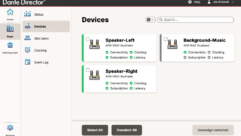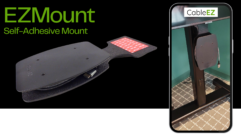
Management Perspectives: Extreme Corporate Makeover
Jan 1, 2007 8:00 PM,
By Don Kreski
How to change your company’s outlook.
Click here to read more Management Perspectives columns

Have you ever lost a project even though you had the low bid? There are many reasons why that might happen, but the most common is that the customer simply doesn’t believe you’re able to finish the job, or finish it as smoothly and as reliably as someone else. There are lots of factors that could contribute to why they might get that impression, but sometimes, it’s just because the AV contractor doesn’t look the part.
“If you have an outdated logo or your letterhead looks like it was created in the 1960s, that just doesn’t say ‘high-tech company,’” Says Bob Carlson, vice president at United Visual, an AV integrator in Itasca, Ill. “It tells people, ‘This is a stagnant company, one that isn’t really aware of what’s going on in the world.’”
Reality TV has brought the concept of extreme makeovers to our culture. Just as changing a hairstyle or a wardrobe can help people change their fortunes, largely because humans naturally react based on visual cues, a makeover can also help your business’ fortunes. If you’ve begun to suspect that your company needs a similar change, the question isn’t so much whether to do it, but how to go about it.
COMPANY MAKEOVER
Carlson says United Visual went through its own major makeover in 1996. (For full disclosure, I’ll note that I was the company’s director of marketing at that time).
“The whole image of our company changed with the new logo design and the new graphic design,” he says. “It stepped the company up a notch. It made us look more professional and more credible in our industry.”
United Visual entered a period of rapid growth after this change, Carlson says. “The company tripled in size in a five year period. A lot of things came together at the same time, but the graphics change certainly was a big part of it. People had a lot more confidence in us seeing the professional presentation of our company.”
One reason the new logo worked so well, according to Carlson, was that it was eye-catching. “Before the change, I never heard customers say that they had noticed our trucks on the road,” he says. “But with the logo change and the updated truck design, lots of people would say, and still say, ‘Oh yeah, I’ve seen those trucks all over the place. They have that very cool design on them.’ Our logo ties in well with our name, and that makes it easy to recall.”
CAPTURING THE ESSENCE
The switch to a new look can be a lengthy process. At United Visual, the logo itself took about four months to create. But that was only the first step. Brad Caldwell, president of Anaheim, Calif.-based Integrated Media Systems, says when he updated his company’s look, it took at least six months to complete the process.
“The logo was only one element,” Caldwell says. “You’re also looking at all the additional support materials that go along with it: the brochures, the website, the business cards. If you create a nice logo, but present it on 5lb. paper, it’s not going to work.”
Typically, the process goes something like this. The person in charge of the project—maybe the company’s president, marketing director, or another manager meets with managers and officers to define, in some brief form, the goals and values of the company. The graphic designer takes these ideas and tries to put them into a visual form. Normally, that takes many iterations, with the designer submitting multiple drawings and management giving feedback, choosing the versions they like best and explaining what they like and dislike about each.
“The goal was to create something that represents the strength of our company and was consistent with our culture,” Caldwell says. “Since it would be seen by people prior to ever speaking with us, it had to represent us in a way that was appropriate, support our message, and help to prompt people to call us.”
Tony Bonilla, who runs a graphic design business outside Chicago, says that when he creates a logo, he tries to capture the essence of the company in its purest form.
“I’m from the school of ‘less is more,’” he says. “A lot of companies try to add too much to the logo. The simpler the icon, the quicker the customer gets what you’re trying to say, the more powerful and better the logo will be.”
Bonilla says he sees the creation of a logo as a distilling process that requires a large number of drawings and a great deal of communication to get right. Sometimes, company mangers don’t understand what he’s trying for.
“You’re looking for the simplicity of an IBM,” he says, “but then they’ll say, ‘Wait a minute. I’m paying X amount of dollars and you’re just giving me three letters?’ ”
Of course, changing the image of a company can be emotionally and politically charged. “To come up with good results,” Carlson adds, “you have to get someone in the ownership on board. Not halfheartedly—they’ve got to really be behind it.”
If you do everything properly—hire the right designer, give him or her the information and feedback they need and the time to do the work—the new look should last a long time.
“If it’s good enough,” Bonilla says, “it should never change. Sometimes a business will change, and sometimes companies tweak logos just to try to modernize them. Look at Coca-Cola. A few years ago they made their logo look different, going to a block type style. But now they went back to what works, what makes people feel good about their product.”
Achieving timelessness may be a lofty goal, however. “Most don’t have the capability or the market presence of a Coca-Cola or an IBM,” Caldwell says. For that reason, Caldwell says a logo will probably need updating every 10 to 15 years, though ideally, you should be able to keep some continuity with the old look of the firm. “Of course, when we made the change we already had a good logo,” he says. “We went through this process once before.”
Carlson, on the other hand, was skillful or lucky enough to come up with something that he says he hopes may last much longer. “Our designer definitely came up with a winning design,” he says. “I’m still happy with it after 10 years. And it’s still current.”
You can reach Don Kreski at










